Clinical Leadership and Management Report: Medication System
VerifiedAdded on 2023/06/04
|8
|1914
|94
Report
AI Summary
This report examines the implementation of an electronic medication system in a 200-bed hospital, addressing medication errors and the need for change. It explores the benefits of the new system, such as time-saving and improved patient care, while also incorporating Lewin's three-step model (unfreezing, changing, refreezing) for effective change management. The report emphasizes the use of transformational leadership to motivate employees and overcome potential resistance to the new system. It compares transformational leadership with autocratic leadership, highlighting the importance of communication and employee involvement. The assignment also discusses potential resistance from staff and customers and suggests strategies to mitigate these challenges, ultimately aiming to improve patient safety and outcomes.
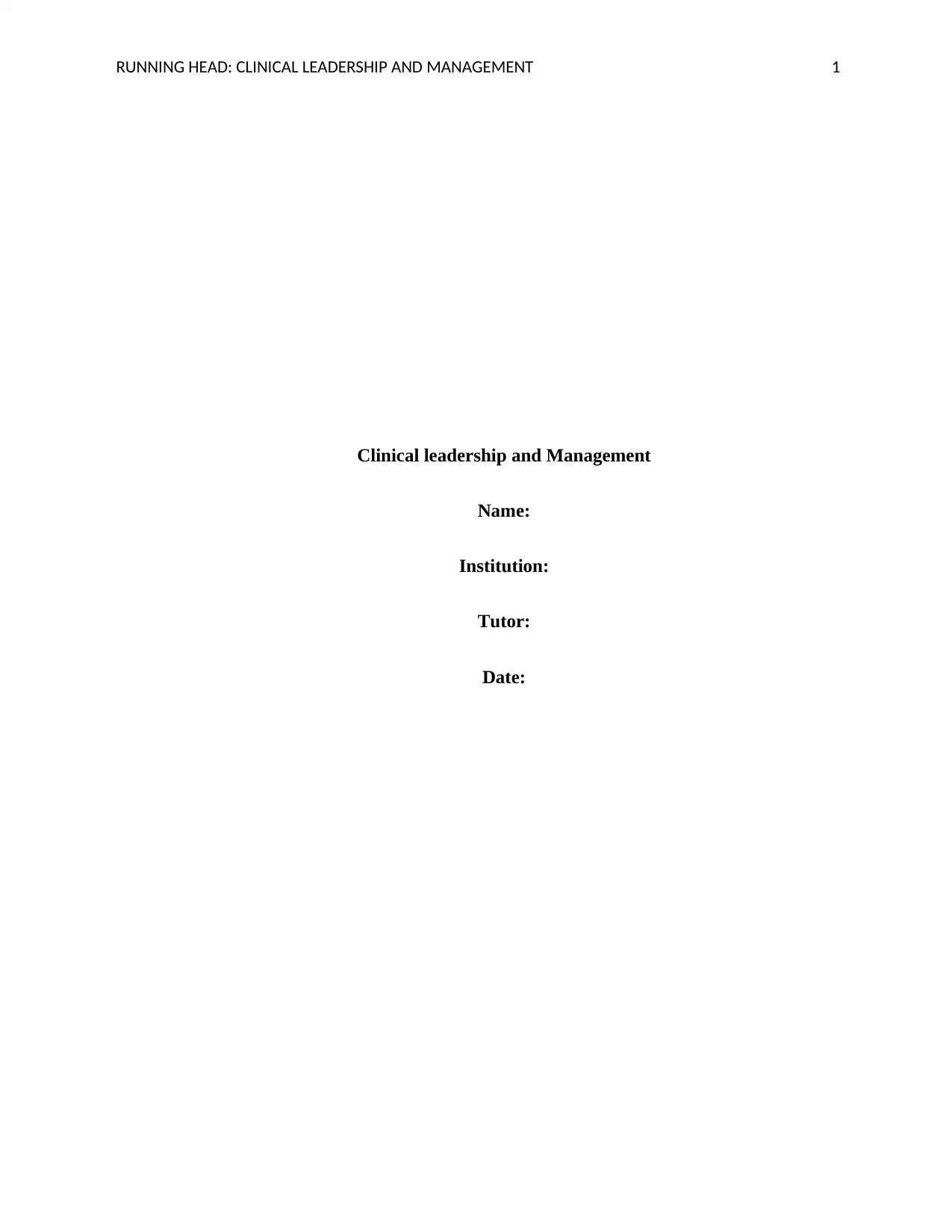
RUNNING HEAD: CLINICAL LEADERSHIP AND MANAGEMENT 1
Clinical leadership and Management
Name:
Institution:
Tutor:
Date:
Clinical leadership and Management
Name:
Institution:
Tutor:
Date:
Paraphrase This Document
Need a fresh take? Get an instant paraphrase of this document with our AI Paraphraser
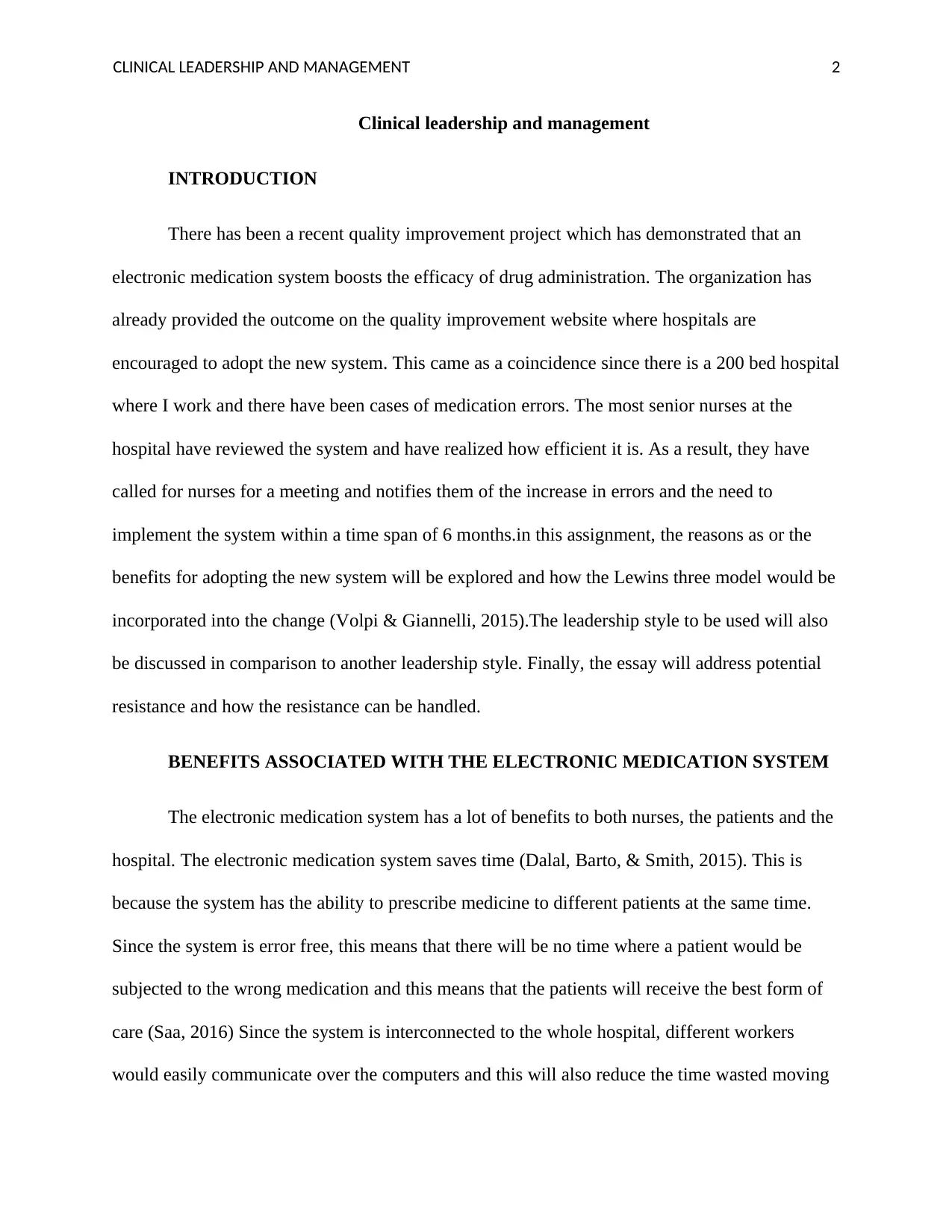
CLINICAL LEADERSHIP AND MANAGEMENT 2
Clinical leadership and management
INTRODUCTION
There has been a recent quality improvement project which has demonstrated that an
electronic medication system boosts the efficacy of drug administration. The organization has
already provided the outcome on the quality improvement website where hospitals are
encouraged to adopt the new system. This came as a coincidence since there is a 200 bed hospital
where I work and there have been cases of medication errors. The most senior nurses at the
hospital have reviewed the system and have realized how efficient it is. As a result, they have
called for nurses for a meeting and notifies them of the increase in errors and the need to
implement the system within a time span of 6 months.in this assignment, the reasons as or the
benefits for adopting the new system will be explored and how the Lewins three model would be
incorporated into the change (Volpi & Giannelli, 2015).The leadership style to be used will also
be discussed in comparison to another leadership style. Finally, the essay will address potential
resistance and how the resistance can be handled.
BENEFITS ASSOCIATED WITH THE ELECTRONIC MEDICATION SYSTEM
The electronic medication system has a lot of benefits to both nurses, the patients and the
hospital. The electronic medication system saves time (Dalal, Barto, & Smith, 2015). This is
because the system has the ability to prescribe medicine to different patients at the same time.
Since the system is error free, this means that there will be no time where a patient would be
subjected to the wrong medication and this means that the patients will receive the best form of
care (Saa, 2016) Since the system is interconnected to the whole hospital, different workers
would easily communicate over the computers and this will also reduce the time wasted moving
Clinical leadership and management
INTRODUCTION
There has been a recent quality improvement project which has demonstrated that an
electronic medication system boosts the efficacy of drug administration. The organization has
already provided the outcome on the quality improvement website where hospitals are
encouraged to adopt the new system. This came as a coincidence since there is a 200 bed hospital
where I work and there have been cases of medication errors. The most senior nurses at the
hospital have reviewed the system and have realized how efficient it is. As a result, they have
called for nurses for a meeting and notifies them of the increase in errors and the need to
implement the system within a time span of 6 months.in this assignment, the reasons as or the
benefits for adopting the new system will be explored and how the Lewins three model would be
incorporated into the change (Volpi & Giannelli, 2015).The leadership style to be used will also
be discussed in comparison to another leadership style. Finally, the essay will address potential
resistance and how the resistance can be handled.
BENEFITS ASSOCIATED WITH THE ELECTRONIC MEDICATION SYSTEM
The electronic medication system has a lot of benefits to both nurses, the patients and the
hospital. The electronic medication system saves time (Dalal, Barto, & Smith, 2015). This is
because the system has the ability to prescribe medicine to different patients at the same time.
Since the system is error free, this means that there will be no time where a patient would be
subjected to the wrong medication and this means that the patients will receive the best form of
care (Saa, 2016) Since the system is interconnected to the whole hospital, different workers
would easily communicate over the computers and this will also reduce the time wasted moving
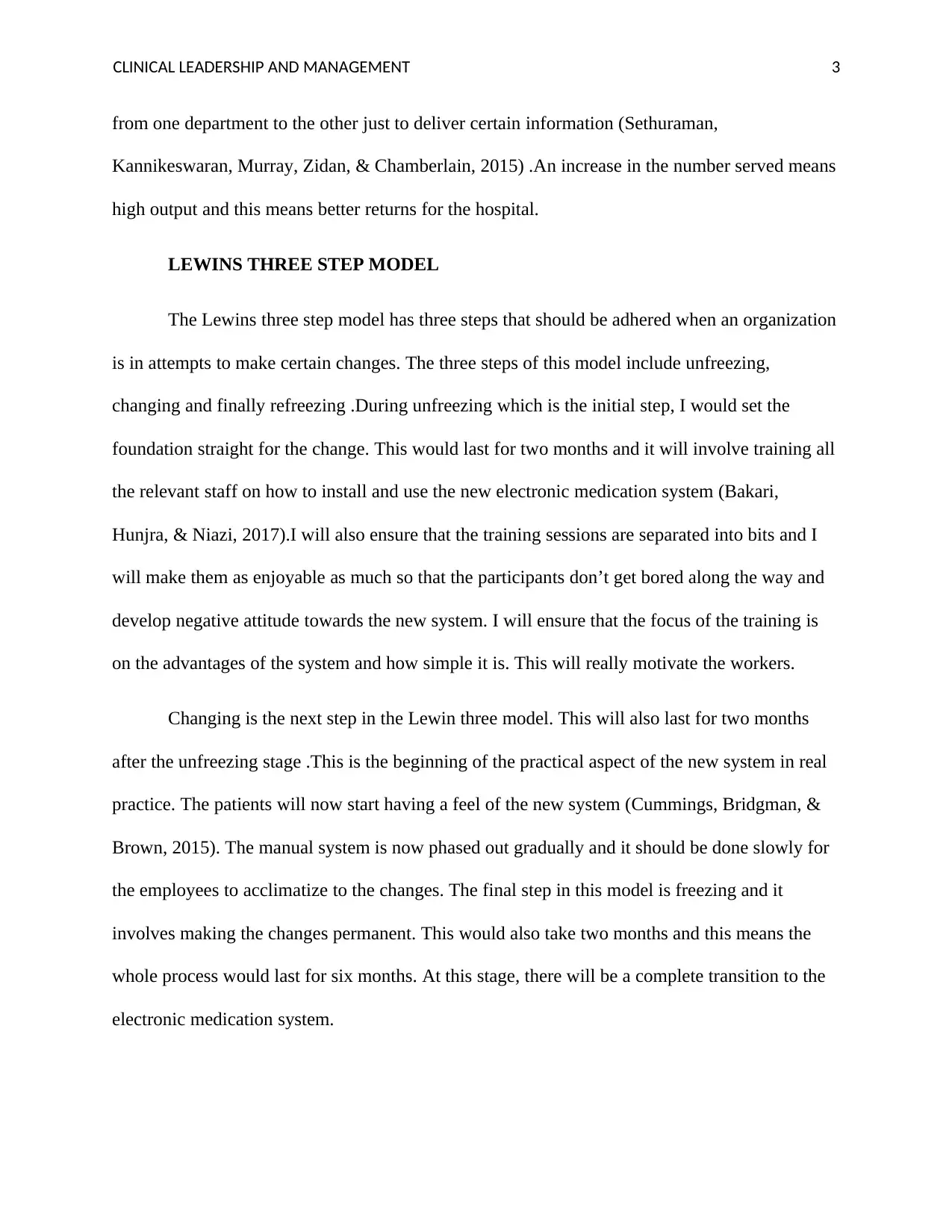
CLINICAL LEADERSHIP AND MANAGEMENT 3
from one department to the other just to deliver certain information (Sethuraman,
Kannikeswaran, Murray, Zidan, & Chamberlain, 2015) .An increase in the number served means
high output and this means better returns for the hospital.
LEWINS THREE STEP MODEL
The Lewins three step model has three steps that should be adhered when an organization
is in attempts to make certain changes. The three steps of this model include unfreezing,
changing and finally refreezing .During unfreezing which is the initial step, I would set the
foundation straight for the change. This would last for two months and it will involve training all
the relevant staff on how to install and use the new electronic medication system (Bakari,
Hunjra, & Niazi, 2017).I will also ensure that the training sessions are separated into bits and I
will make them as enjoyable as much so that the participants don’t get bored along the way and
develop negative attitude towards the new system. I will ensure that the focus of the training is
on the advantages of the system and how simple it is. This will really motivate the workers.
Changing is the next step in the Lewin three model. This will also last for two months
after the unfreezing stage .This is the beginning of the practical aspect of the new system in real
practice. The patients will now start having a feel of the new system (Cummings, Bridgman, &
Brown, 2015). The manual system is now phased out gradually and it should be done slowly for
the employees to acclimatize to the changes. The final step in this model is freezing and it
involves making the changes permanent. This would also take two months and this means the
whole process would last for six months. At this stage, there will be a complete transition to the
electronic medication system.
from one department to the other just to deliver certain information (Sethuraman,
Kannikeswaran, Murray, Zidan, & Chamberlain, 2015) .An increase in the number served means
high output and this means better returns for the hospital.
LEWINS THREE STEP MODEL
The Lewins three step model has three steps that should be adhered when an organization
is in attempts to make certain changes. The three steps of this model include unfreezing,
changing and finally refreezing .During unfreezing which is the initial step, I would set the
foundation straight for the change. This would last for two months and it will involve training all
the relevant staff on how to install and use the new electronic medication system (Bakari,
Hunjra, & Niazi, 2017).I will also ensure that the training sessions are separated into bits and I
will make them as enjoyable as much so that the participants don’t get bored along the way and
develop negative attitude towards the new system. I will ensure that the focus of the training is
on the advantages of the system and how simple it is. This will really motivate the workers.
Changing is the next step in the Lewin three model. This will also last for two months
after the unfreezing stage .This is the beginning of the practical aspect of the new system in real
practice. The patients will now start having a feel of the new system (Cummings, Bridgman, &
Brown, 2015). The manual system is now phased out gradually and it should be done slowly for
the employees to acclimatize to the changes. The final step in this model is freezing and it
involves making the changes permanent. This would also take two months and this means the
whole process would last for six months. At this stage, there will be a complete transition to the
electronic medication system.
⊘ This is a preview!⊘
Do you want full access?
Subscribe today to unlock all pages.

Trusted by 1+ million students worldwide
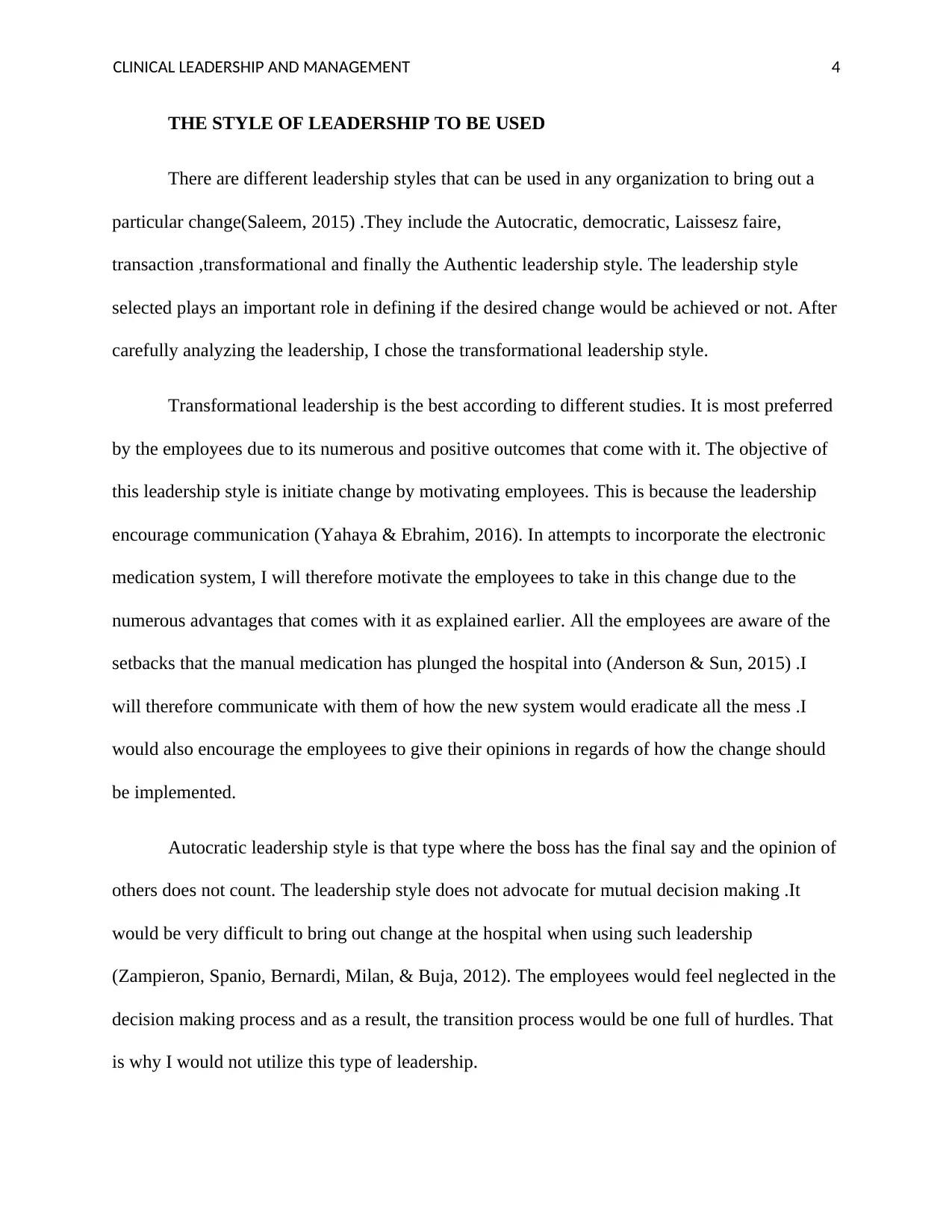
CLINICAL LEADERSHIP AND MANAGEMENT 4
THE STYLE OF LEADERSHIP TO BE USED
There are different leadership styles that can be used in any organization to bring out a
particular change(Saleem, 2015) .They include the Autocratic, democratic, Laissesz faire,
transaction ,transformational and finally the Authentic leadership style. The leadership style
selected plays an important role in defining if the desired change would be achieved or not. After
carefully analyzing the leadership, I chose the transformational leadership style.
Transformational leadership is the best according to different studies. It is most preferred
by the employees due to its numerous and positive outcomes that come with it. The objective of
this leadership style is initiate change by motivating employees. This is because the leadership
encourage communication (Yahaya & Ebrahim, 2016). In attempts to incorporate the electronic
medication system, I will therefore motivate the employees to take in this change due to the
numerous advantages that comes with it as explained earlier. All the employees are aware of the
setbacks that the manual medication has plunged the hospital into (Anderson & Sun, 2015) .I
will therefore communicate with them of how the new system would eradicate all the mess .I
would also encourage the employees to give their opinions in regards of how the change should
be implemented.
Autocratic leadership style is that type where the boss has the final say and the opinion of
others does not count. The leadership style does not advocate for mutual decision making .It
would be very difficult to bring out change at the hospital when using such leadership
(Zampieron, Spanio, Bernardi, Milan, & Buja, 2012). The employees would feel neglected in the
decision making process and as a result, the transition process would be one full of hurdles. That
is why I would not utilize this type of leadership.
THE STYLE OF LEADERSHIP TO BE USED
There are different leadership styles that can be used in any organization to bring out a
particular change(Saleem, 2015) .They include the Autocratic, democratic, Laissesz faire,
transaction ,transformational and finally the Authentic leadership style. The leadership style
selected plays an important role in defining if the desired change would be achieved or not. After
carefully analyzing the leadership, I chose the transformational leadership style.
Transformational leadership is the best according to different studies. It is most preferred
by the employees due to its numerous and positive outcomes that come with it. The objective of
this leadership style is initiate change by motivating employees. This is because the leadership
encourage communication (Yahaya & Ebrahim, 2016). In attempts to incorporate the electronic
medication system, I will therefore motivate the employees to take in this change due to the
numerous advantages that comes with it as explained earlier. All the employees are aware of the
setbacks that the manual medication has plunged the hospital into (Anderson & Sun, 2015) .I
will therefore communicate with them of how the new system would eradicate all the mess .I
would also encourage the employees to give their opinions in regards of how the change should
be implemented.
Autocratic leadership style is that type where the boss has the final say and the opinion of
others does not count. The leadership style does not advocate for mutual decision making .It
would be very difficult to bring out change at the hospital when using such leadership
(Zampieron, Spanio, Bernardi, Milan, & Buja, 2012). The employees would feel neglected in the
decision making process and as a result, the transition process would be one full of hurdles. That
is why I would not utilize this type of leadership.
Paraphrase This Document
Need a fresh take? Get an instant paraphrase of this document with our AI Paraphraser
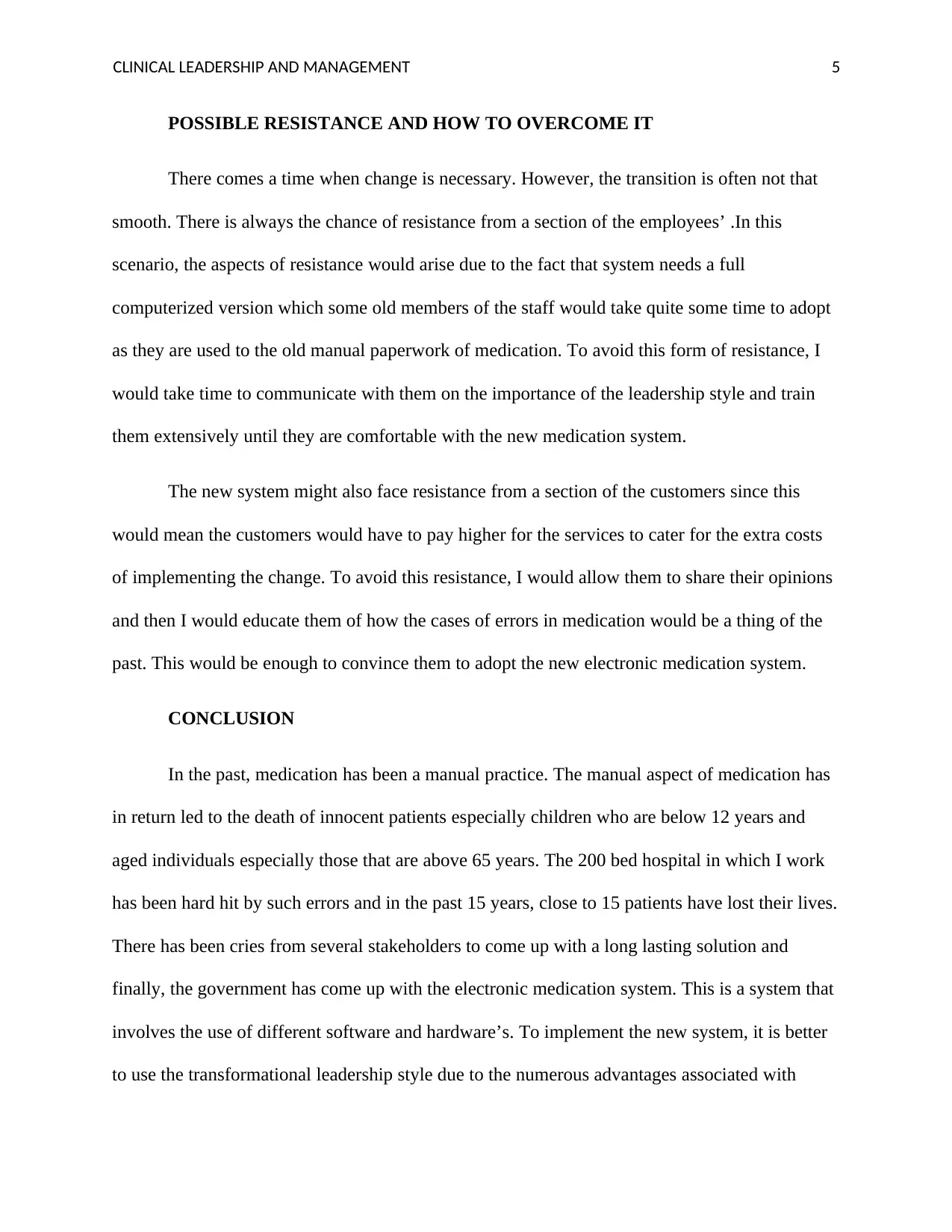
CLINICAL LEADERSHIP AND MANAGEMENT 5
POSSIBLE RESISTANCE AND HOW TO OVERCOME IT
There comes a time when change is necessary. However, the transition is often not that
smooth. There is always the chance of resistance from a section of the employees’ .In this
scenario, the aspects of resistance would arise due to the fact that system needs a full
computerized version which some old members of the staff would take quite some time to adopt
as they are used to the old manual paperwork of medication. To avoid this form of resistance, I
would take time to communicate with them on the importance of the leadership style and train
them extensively until they are comfortable with the new medication system.
The new system might also face resistance from a section of the customers since this
would mean the customers would have to pay higher for the services to cater for the extra costs
of implementing the change. To avoid this resistance, I would allow them to share their opinions
and then I would educate them of how the cases of errors in medication would be a thing of the
past. This would be enough to convince them to adopt the new electronic medication system.
CONCLUSION
In the past, medication has been a manual practice. The manual aspect of medication has
in return led to the death of innocent patients especially children who are below 12 years and
aged individuals especially those that are above 65 years. The 200 bed hospital in which I work
has been hard hit by such errors and in the past 15 years, close to 15 patients have lost their lives.
There has been cries from several stakeholders to come up with a long lasting solution and
finally, the government has come up with the electronic medication system. This is a system that
involves the use of different software and hardware’s. To implement the new system, it is better
to use the transformational leadership style due to the numerous advantages associated with
POSSIBLE RESISTANCE AND HOW TO OVERCOME IT
There comes a time when change is necessary. However, the transition is often not that
smooth. There is always the chance of resistance from a section of the employees’ .In this
scenario, the aspects of resistance would arise due to the fact that system needs a full
computerized version which some old members of the staff would take quite some time to adopt
as they are used to the old manual paperwork of medication. To avoid this form of resistance, I
would take time to communicate with them on the importance of the leadership style and train
them extensively until they are comfortable with the new medication system.
The new system might also face resistance from a section of the customers since this
would mean the customers would have to pay higher for the services to cater for the extra costs
of implementing the change. To avoid this resistance, I would allow them to share their opinions
and then I would educate them of how the cases of errors in medication would be a thing of the
past. This would be enough to convince them to adopt the new electronic medication system.
CONCLUSION
In the past, medication has been a manual practice. The manual aspect of medication has
in return led to the death of innocent patients especially children who are below 12 years and
aged individuals especially those that are above 65 years. The 200 bed hospital in which I work
has been hard hit by such errors and in the past 15 years, close to 15 patients have lost their lives.
There has been cries from several stakeholders to come up with a long lasting solution and
finally, the government has come up with the electronic medication system. This is a system that
involves the use of different software and hardware’s. To implement the new system, it is better
to use the transformational leadership style due to the numerous advantages associated with
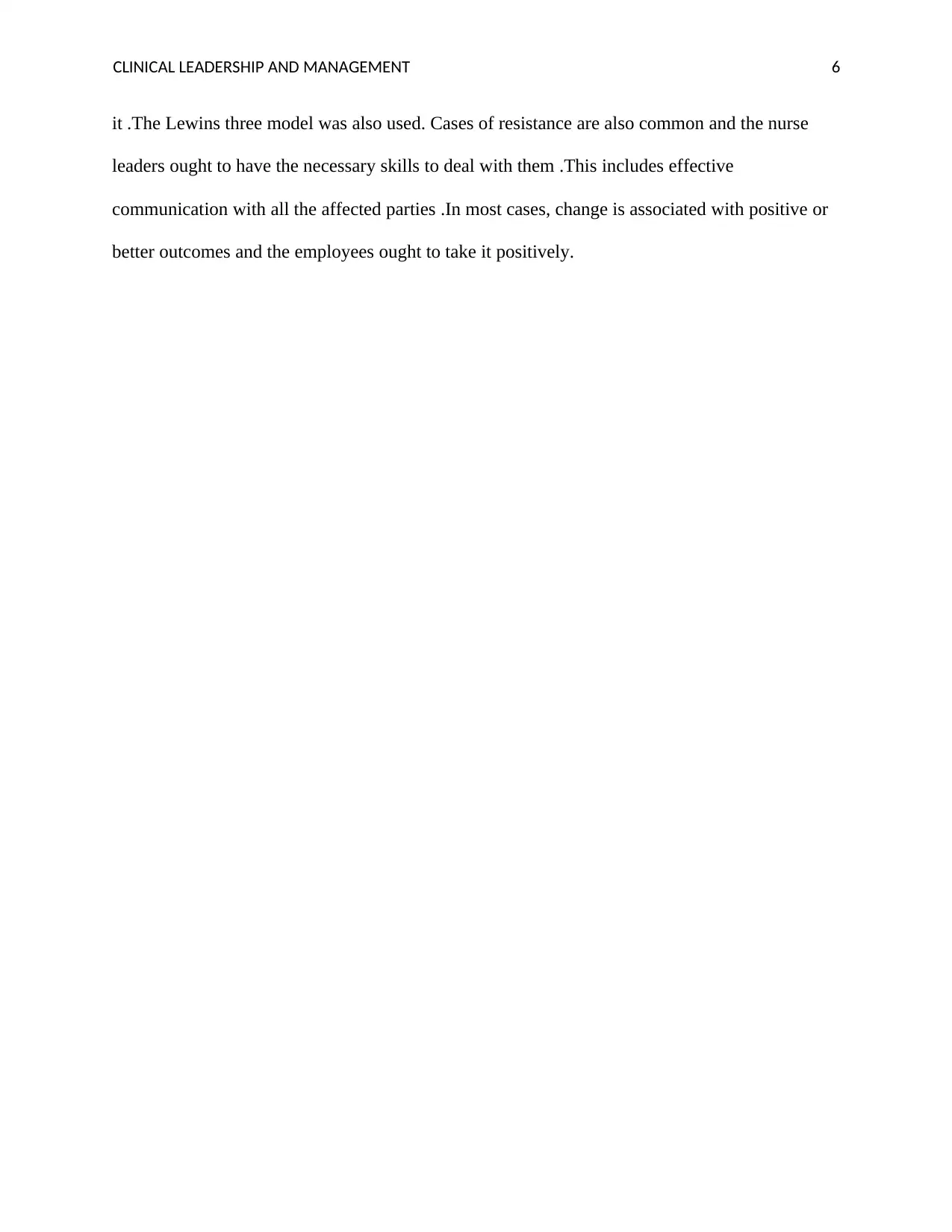
CLINICAL LEADERSHIP AND MANAGEMENT 6
it .The Lewins three model was also used. Cases of resistance are also common and the nurse
leaders ought to have the necessary skills to deal with them .This includes effective
communication with all the affected parties .In most cases, change is associated with positive or
better outcomes and the employees ought to take it positively.
it .The Lewins three model was also used. Cases of resistance are also common and the nurse
leaders ought to have the necessary skills to deal with them .This includes effective
communication with all the affected parties .In most cases, change is associated with positive or
better outcomes and the employees ought to take it positively.
⊘ This is a preview!⊘
Do you want full access?
Subscribe today to unlock all pages.

Trusted by 1+ million students worldwide
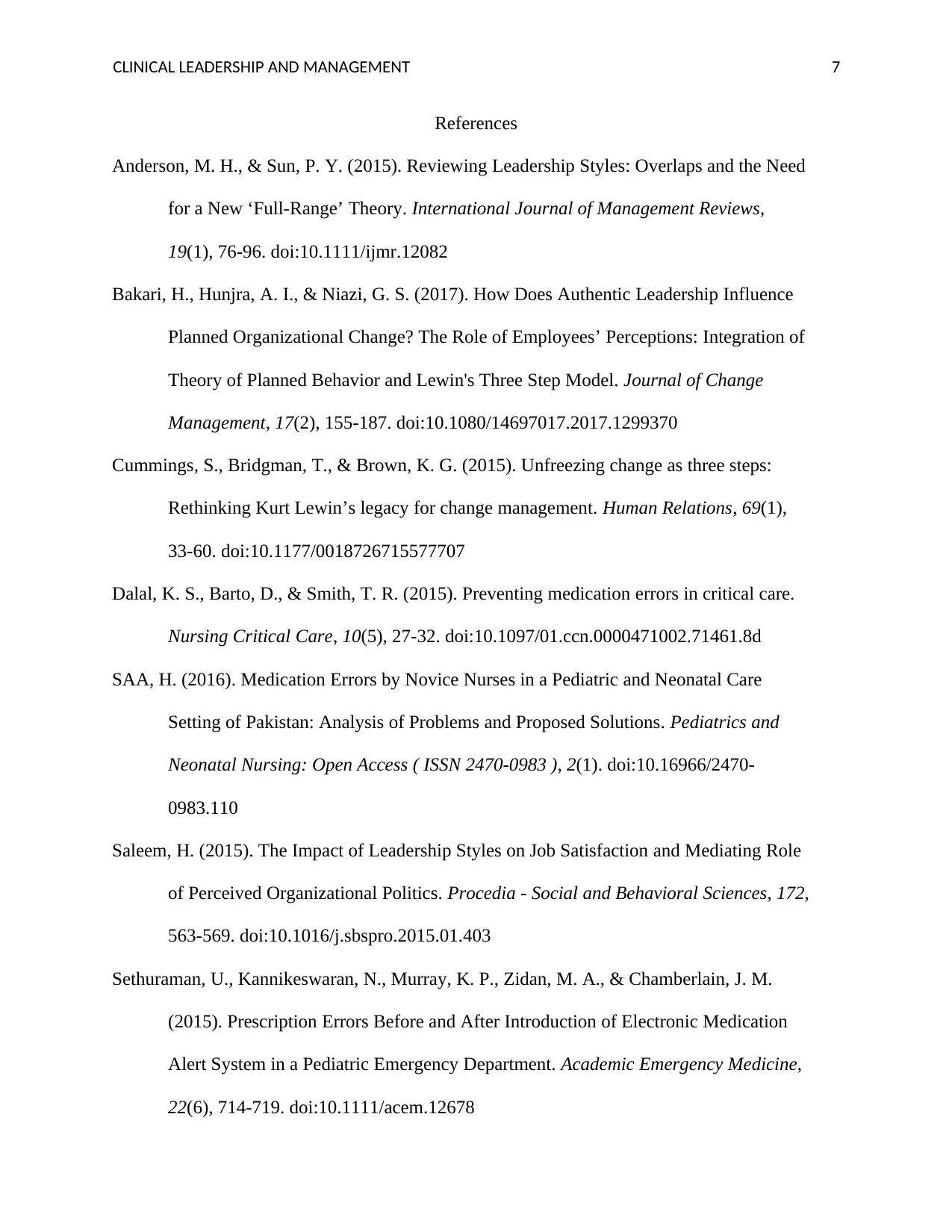
CLINICAL LEADERSHIP AND MANAGEMENT 7
References
Anderson, M. H., & Sun, P. Y. (2015). Reviewing Leadership Styles: Overlaps and the Need
for a New ‘Full-Range’ Theory. International Journal of Management Reviews,
19(1), 76-96. doi:10.1111/ijmr.12082
Bakari, H., Hunjra, A. I., & Niazi, G. S. (2017). How Does Authentic Leadership Influence
Planned Organizational Change? The Role of Employees’ Perceptions: Integration of
Theory of Planned Behavior and Lewin's Three Step Model. Journal of Change
Management, 17(2), 155-187. doi:10.1080/14697017.2017.1299370
Cummings, S., Bridgman, T., & Brown, K. G. (2015). Unfreezing change as three steps:
Rethinking Kurt Lewin’s legacy for change management. Human Relations, 69(1),
33-60. doi:10.1177/0018726715577707
Dalal, K. S., Barto, D., & Smith, T. R. (2015). Preventing medication errors in critical care.
Nursing Critical Care, 10(5), 27-32. doi:10.1097/01.ccn.0000471002.71461.8d
SAA, H. (2016). Medication Errors by Novice Nurses in a Pediatric and Neonatal Care
Setting of Pakistan: Analysis of Problems and Proposed Solutions. Pediatrics and
Neonatal Nursing: Open Access ( ISSN 2470-0983 ), 2(1). doi:10.16966/2470-
0983.110
Saleem, H. (2015). The Impact of Leadership Styles on Job Satisfaction and Mediating Role
of Perceived Organizational Politics. Procedia - Social and Behavioral Sciences, 172,
563-569. doi:10.1016/j.sbspro.2015.01.403
Sethuraman, U., Kannikeswaran, N., Murray, K. P., Zidan, M. A., & Chamberlain, J. M.
(2015). Prescription Errors Before and After Introduction of Electronic Medication
Alert System in a Pediatric Emergency Department. Academic Emergency Medicine,
22(6), 714-719. doi:10.1111/acem.12678
References
Anderson, M. H., & Sun, P. Y. (2015). Reviewing Leadership Styles: Overlaps and the Need
for a New ‘Full-Range’ Theory. International Journal of Management Reviews,
19(1), 76-96. doi:10.1111/ijmr.12082
Bakari, H., Hunjra, A. I., & Niazi, G. S. (2017). How Does Authentic Leadership Influence
Planned Organizational Change? The Role of Employees’ Perceptions: Integration of
Theory of Planned Behavior and Lewin's Three Step Model. Journal of Change
Management, 17(2), 155-187. doi:10.1080/14697017.2017.1299370
Cummings, S., Bridgman, T., & Brown, K. G. (2015). Unfreezing change as three steps:
Rethinking Kurt Lewin’s legacy for change management. Human Relations, 69(1),
33-60. doi:10.1177/0018726715577707
Dalal, K. S., Barto, D., & Smith, T. R. (2015). Preventing medication errors in critical care.
Nursing Critical Care, 10(5), 27-32. doi:10.1097/01.ccn.0000471002.71461.8d
SAA, H. (2016). Medication Errors by Novice Nurses in a Pediatric and Neonatal Care
Setting of Pakistan: Analysis of Problems and Proposed Solutions. Pediatrics and
Neonatal Nursing: Open Access ( ISSN 2470-0983 ), 2(1). doi:10.16966/2470-
0983.110
Saleem, H. (2015). The Impact of Leadership Styles on Job Satisfaction and Mediating Role
of Perceived Organizational Politics. Procedia - Social and Behavioral Sciences, 172,
563-569. doi:10.1016/j.sbspro.2015.01.403
Sethuraman, U., Kannikeswaran, N., Murray, K. P., Zidan, M. A., & Chamberlain, J. M.
(2015). Prescription Errors Before and After Introduction of Electronic Medication
Alert System in a Pediatric Emergency Department. Academic Emergency Medicine,
22(6), 714-719. doi:10.1111/acem.12678
Paraphrase This Document
Need a fresh take? Get an instant paraphrase of this document with our AI Paraphraser
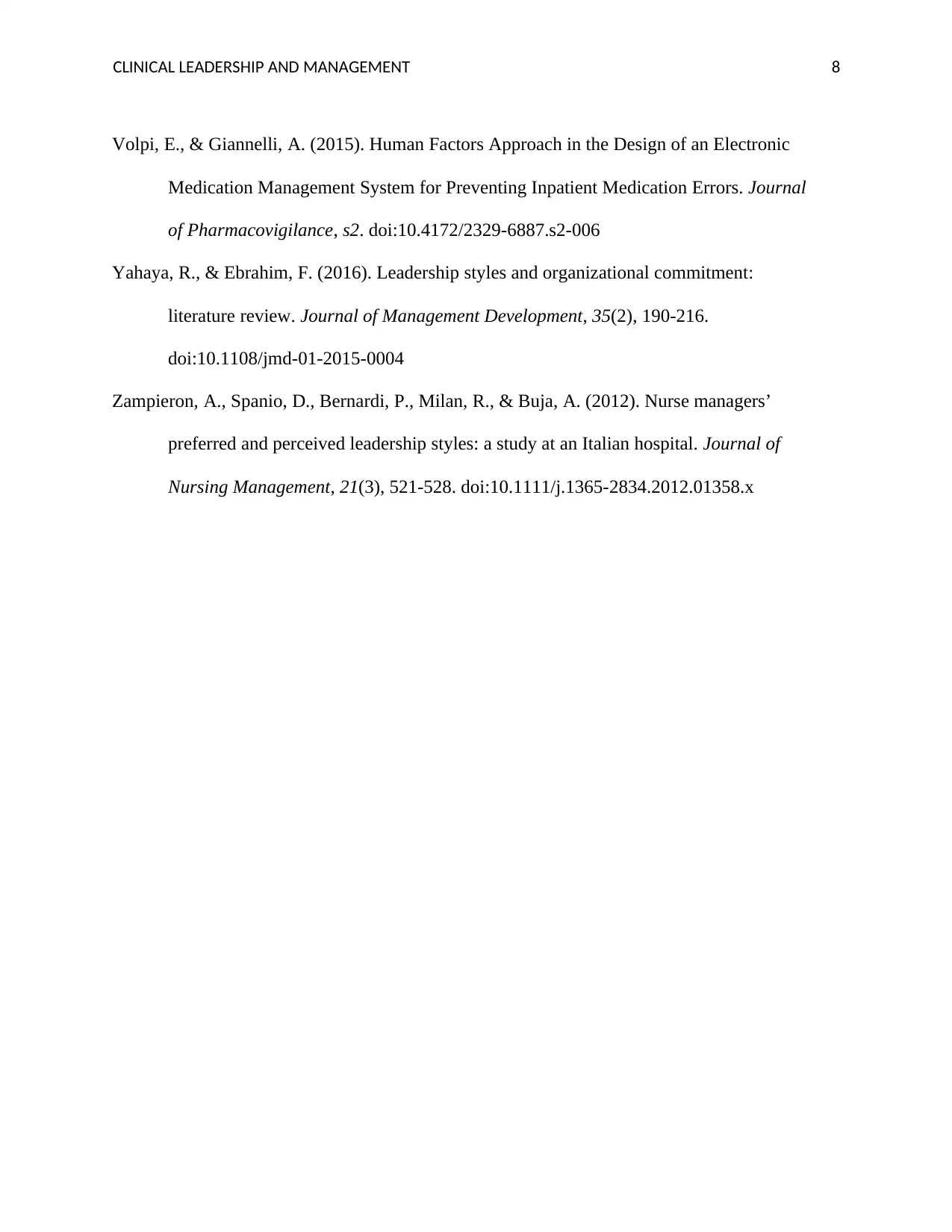
CLINICAL LEADERSHIP AND MANAGEMENT 8
Volpi, E., & Giannelli, A. (2015). Human Factors Approach in the Design of an Electronic
Medication Management System for Preventing Inpatient Medication Errors. Journal
of Pharmacovigilance, s2. doi:10.4172/2329-6887.s2-006
Yahaya, R., & Ebrahim, F. (2016). Leadership styles and organizational commitment:
literature review. Journal of Management Development, 35(2), 190-216.
doi:10.1108/jmd-01-2015-0004
Zampieron, A., Spanio, D., Bernardi, P., Milan, R., & Buja, A. (2012). Nurse managers’
preferred and perceived leadership styles: a study at an Italian hospital. Journal of
Nursing Management, 21(3), 521-528. doi:10.1111/j.1365-2834.2012.01358.x
Volpi, E., & Giannelli, A. (2015). Human Factors Approach in the Design of an Electronic
Medication Management System for Preventing Inpatient Medication Errors. Journal
of Pharmacovigilance, s2. doi:10.4172/2329-6887.s2-006
Yahaya, R., & Ebrahim, F. (2016). Leadership styles and organizational commitment:
literature review. Journal of Management Development, 35(2), 190-216.
doi:10.1108/jmd-01-2015-0004
Zampieron, A., Spanio, D., Bernardi, P., Milan, R., & Buja, A. (2012). Nurse managers’
preferred and perceived leadership styles: a study at an Italian hospital. Journal of
Nursing Management, 21(3), 521-528. doi:10.1111/j.1365-2834.2012.01358.x
1 out of 8
Related Documents
Your All-in-One AI-Powered Toolkit for Academic Success.
+13062052269
info@desklib.com
Available 24*7 on WhatsApp / Email
![[object Object]](/_next/static/media/star-bottom.7253800d.svg)
Unlock your academic potential
Copyright © 2020–2025 A2Z Services. All Rights Reserved. Developed and managed by ZUCOL.





